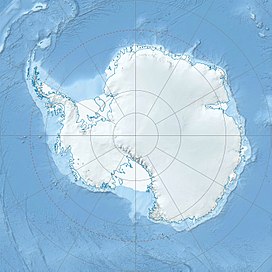The Columbia Mountains (70°14′S 63°51′W / 70.233°S 63.850°W) are a group of largely bare rock peaks, ridges and nunataks located near the east margin of the Dyer Plateau, 20 nautical miles (37 km; 23 mi) south-east of the Eternity Range, in Palmer Land, Antarctica.[1]
| Columbia Mountains | |
|---|---|
| Geography | |
| Region(s) | Palmer Land, Antarctica |
| Range coordinates | 70°14′S 63°51′W / 70.233°S 63.850°W |
Location
editThe Columbia Mountains are in central Palmer Land, between the George VI Sound to the east and Marguerite Bay to the west. They are south of the Eternity Range, east of the Dyer Plateau, northwest of the Eland Mountains and west of Smith Inlet and Hughes Ice Piedmont. Features, from north to south, include Mount Brocoum, Dalziel Ridge, Bardsdell Nunatak, Pinther Ridge and Mikus Hill. The Anckorn Nunataks are to the east.[2]
Mapping and name
editThe Columbia Mountains were mapped by the United States Geological Survey (USGS) in 1974. They were named by the United States Advisory Committee on Antarctic Names (US.ACAN) after Columbia University, New York City, which for several seasons in the 1960s and 1970s sent geologists to study the structure of the Scotia Ridge.[1]
Features
editMount Brocoum
edit70°12′S 63°45′W / 70.200°S 63.750°W. The dominant peak on the eastern ridge of the Columbia Mountains. Mapped by the USGS in 1974. Named by US-ACAN for Stephan J. Brocoum and his wife, Alice V. Brocoum, Columbia University geologists who studied the structure of the Scotia Ridge area. He worked in 1968-69 and 1970-71; she, only the latter season.[3]
Dalziel Ridge
edit70°15′S 63°55′W / 70.250°S 63.917°W. The primary, western ridge of the Columbia Mountains. There is considerable exposure of bare rock along the west slopes of the feature. Mapped by the USGS in 1974. Named by US-ACAN for lan W.D. Dalziel, British geologist now at Columbia University, in several recent seasons (late 1960's to 1976) the principal USARP investigator of the structure and petrology of the Scotia Ridge area.[4]
Bardsdell Nunatak
edit70°16′S 63°54′W / 70.267°S 63.900°W. A mainly ice-free nunatak just north of Dalziel Ridge in the Columbia Mountains. Mapped by the USGS in 1974. Named by US-ACAN for Mark Bardsdell, Columbia University geologist who studied the structure of the Scotia Ridge area, 1970-71.[5]
Nearby features
editPinther Ridge
edit70°22′S 64°20′W / 70.367°S 64.333°W. An arc-shaped mountain ridge, 6 nautical miles (11 km; 6.9 mi) long, that is somewhat isolated and mostly snow covered. It rises above the ice surface at the east margin of the Dyer Plateau, about 22 nautical miles (41 km; 25 mi) south of the Eternity Range. Mapped by USGS in 1974. Named by US-ACAN for Miklos Pinther, Chief Cartographer of the American Geographical Society in the 1970's, under whose supervision a number of excellent maps of Antarctica have been prepared.[6]
Mikus Hill
edit70°27′S 63°50′W / 70.450°S 63.833°W. A hill with a number of bare rock exposures, surmounting the southwest wall of Richardson Glacier. Mapped by USGS in 1974. Named by US-ACAN for Edward J. Mikus, PH3, United States Navy, photographer of the cartographic aerial mapping crew in LC-130 aircraft of Squadron VXE-6, 1968-69.[7]
Anckorn Nunataks
edit70°14′S 63°12′W / 70.233°S 63.200°W. A group of nunataks and snow-covered hills, 15 nautical miles (28 km; 17 mi) long, between Mount Bailey and Mount Samsel in the east part of Palmer Land. Named by the UK Antarctic Place-Names Committee (UK-APC) after J.F. Anckorn, BAS geologist who worked in the vicinity of this feature.[8]
Mount Samsel
edit70°24′S 63°15′W / 70.400°S 63.250°W. A mountain along the north side of Clifford Glacier, just west of the juncture of the Kubitza Glacier. Mapped by USGS in 1974. Named by US-ACAN for Gene L. Samsel, United States Antarctic Research Program (USARP) biologist at Palmer Station in the 1969-70 and 1970-71 seasons.[9]
References
edit- ^ a b Alberts 1995, p. 146.
- ^ Palmer Land USGS.
- ^ Alberts 1995, p. 95.
- ^ Alberts 1995, p. 171.
- ^ Alberts 1995, p. 44.
- ^ Alberts 1995, p. 577.
- ^ Alberts 1995, p. 491.
- ^ Alberts 1995, p. 18.
- ^ Alberts 1995, p. 645.
Sources
edit- Alberts, Fred G., ed. (1995), Geographic Names of the Antarctic (PDF) (2 ed.), United States Board on Geographic Names, retrieved 2023-12-03 This article incorporates public domain material from websites or documents of the United States Board on Geographic Names.
- Palmer Land, USGS: United States Geological Survey, retrieved 2024-04-25
This article incorporates public domain material from websites or documents of the United States Geological Survey.
